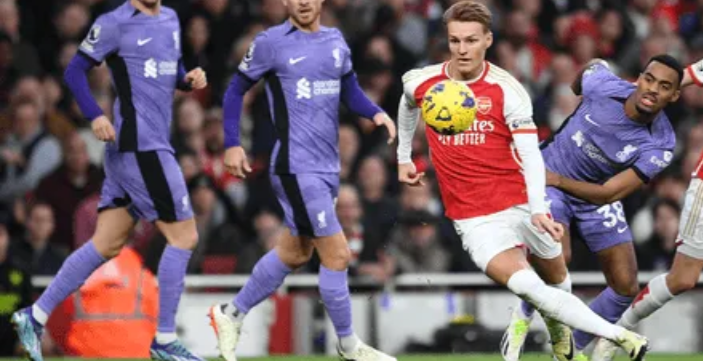Sunday saw us produce a dominant display at home to the league leaders, responding to a first-half setback to earn an impressive 3-1 win against Liverpool.
To find out the keys to our success, Adrian Clarke has delved into the tactical and statistical side of the game to find the subtle reasons why we were able to deliver such an excellent performance.
The foundation of this outstanding team performance was a desire to outwork and outmuscle Jurgen Klopp’s Liverpool.
Our pressing from the front, triggered by Martin Odegaard, Kai Havertz and Gabriel Martinelli (backed up by everybody else) was at it’s hostile best. Given precious little time to settle on the ball, Liverpool’s defensive players were consistently pressurised, especially during a tumultuous first period.
Mikel Arteta’s men regained possession inside the final third on eight occasions compared to the visitors’ one; and this is a stat that indicates how aggressive we were in our off the ball work.
We won 52.3% of duels and made 21 tackles to Liverpool’s 11.
As a team we also ran 116.8km, which was an astonishing 6.1km further than Jurgen Klopp’s table toppers, with skipper Odegaard leading by example.
Covering 12.75km himself, the Norwegian put in a monumental shift that was his personal best of the campaign, and the second highest individual figure overall.
The manager made a key tactical change by adding Jorginho to the starting XI and it was a move which paid off handsomely.
Alongside the brilliant Declan Rice in a double pivot, the Italian was top class in and out of possession.
Bringing an air of calm serenity to the engine room, the 32-year-old made a string of incisive forward passes that led to quality chances.
Below are four examples of how he pierced Liverpool’s rearguard with a crisp forward pass.
No Arsenal player made more passes overall, or inside the opposition half and final third than Jorginho.
He also played his part defensively too, making a team-high four interceptions.
Arteta’s decision to start Jorginho in a bid to offer more control and experience was a great call.
During a largely superb first half performance the shape of the side was more akin to a 4-4-2, with Kai Havertz and Martin Odegaard performing as a pair of ‘false strikers.’
Whenever we pressed high they would occupy a central defender each, and behind them Rice and Jorginho also pushed on man-to-man with the first line of Liverpool’s central midfielders.
As shown in the example below, this tactic made it incredibly hard for our opponents to play through the spine of the pitch.
And in moments where we had to sit off behind the ball and keep a solid shape, this box of four players (below) would retreat to ensure it was Arsenal who held the numerical advantage in that part of the pitch.

